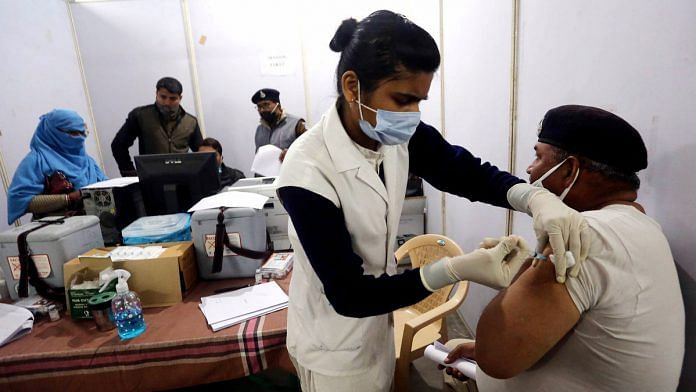New Delhi: A slew of vaccines are in different stages of development or clinical trials in India, but it could be a “few months” before any of them get emergency use authorisation, NITI Aayog’s Member (Health) Dr V.K. Paul said Tuesday.
Replying to a query from ThePrint about when Covid-19 vaccines would be available for sale outside of the national programme, Paul said at a press briefing the priority for the government was to inoculate the priority groups of 30 crore vulnerable people.
“First and foremost, the comprehensive goal is to achieve the public health objective of vaccinating 30 crore people. That is where the vaccine stockpile will be channelled on priority. If the availability is over and above that requirement… we still have to wait for a few months before any of these (other) vaccines become available through emergency use authorisation,” he said. “Protecting large populations from mortality, should they get Covid-19, is the priority.”
While Paul did not specify an actual timeline for when vaccines may be available in the private sector, sources said for supplies to ease to that extent may also take a few months, perhaps even half a year.
Among the vaccines that Dr Paul mentioned as “holding promise” are the Russian vaccine Sputnik V, which he said is tying up with more industry partners, and the DNA vaccines from Zydus Cadila, whose phase III trials are being watched keenly by the government.
He also mentioned the nasal vaccine being developed by Bharat Biotech, and Novavax, which is being developed by the Serum Institute of India. Currently, SII’s Covishield and Bharat Biotech’s Covaxin are the two vaccines being given to healthcare and frontline workers.
Also read: Why India’s expert panel rejected Pfizer plea for emergency use nod to its Covid vaccine
1 in 1,400 people have minor adverse reactions
Paul said data coming in on adverse effects following immunisation (AEFIs) has “reaffirmed that both vaccines are superbly safe”.
“Of the 63,10,194 people vaccinated, 0.07 per cent have reported AEFIs. This is one in 1,400 people. These are also mild effects like rashes or fever etc.”
Another important issue Paul discussed was which strains of the virus have been found in India — he said while the variant discovered in South Africa is yet to enter the country, the government is continuing with the gene-sequencing process that led to the identification of cases of the mutation discovered in the UK.
How states have performed on vaccination
States that have done well in vaccinating healthcare workers include Bihar (78.1 per cent), Tripura (77.1 per cent) and Madhya Pradesh (76.0 per cent), Union Health Secretary Rajesh Bhushan said at the same press briefing.
He added that 11 states and union territories have failed to reach 40 per cent of the target.
“We have told states to ensure that all healthcare workers have got at least one dose by 20 February, and then they can hold mop-up rounds till 24 February. After that, HCWs will be relegated to the age-appropriate groups, and will have to wait for their turn,” Bhushan said.
“Frontline workers should have got one dose by 1 March, and mop-up rounds can happen till 6 March. After that, they too will have to wait for their turn by age,” he added.
Also read: Co-WIN isn’t fashion but a necessity, says RS Sharma, ex-TRAI chief in charge of vaccine app







Is it not 1 in 4400 (4417 actually) having AEFI based on the quoted figures